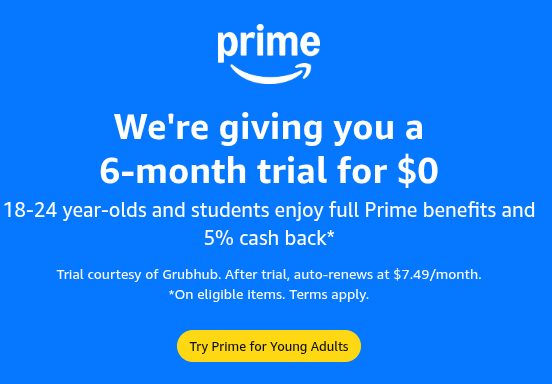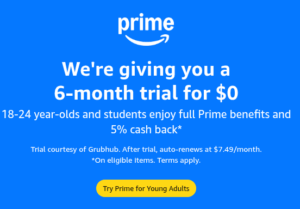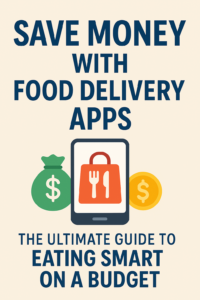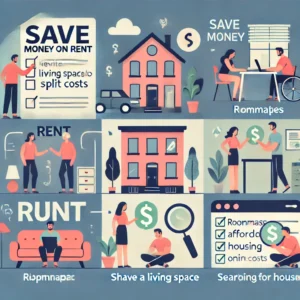Life as a student or young adult is busy and expensive. Between tuition, books, rent, and late-night study snacks, every dollar matters. That’s why Amazon Prime offers an exclusive deal just for students and young adults: a way to get Amazon Prime completely free for 6 months — with no strings attached.
Here’s how it works, what you’ll get, and how to claim it in under 2 minutes.
🎁 What is Amazon Prime Student?
Amazon Prime Student (also called Prime for Young Adults) is a discounted version of Amazon Prime built specifically for college and university students — and it comes with a 6-month free trial.
After the trial, you get 50% off Prime — just $7.49/month, compared to the regular $14.99.
📝 Who Qualifies?
To get free Amazon Prime as a student or young adult, you must:
- Be enrolled in a college, university, or CEGEP (part-time or full-time)
- Have a valid .edu email or be able to upload proof of enrollment (student card, schedule, etc.)
- Be 18–24 years old (Prime for Young Adults applies to this age group)
- Have not already had a Prime Student trial before
👉 Click here to see if you qualify and start your free trial
🔓 What’s Included in the Free Trial?
This isn’t a stripped-down version of Prime — you get all the same features:
✅ Free Shipping
- Unlimited 2-day and 1-day shipping
- Same-day delivery in many areas
- Perfect for textbooks, last-minute essentials, or dorm upgrades
✅ Prime Video
- Stream hit shows, Amazon Originals, and movies for free
- Binge-watch over the weekend without another streaming subscription
✅ Amazon Music
- 100 million+ ad-free songs
- Optional upgrade to Music Unlimited for only $0.99/month (exclusive to students)
✅ Prime Reading + Free Games
- Borrow eBooks, comics, and magazines
- Get free in-game content and Twitch Prime benefits
✅ Exclusive Student Discounts
- Save on laptops, school supplies, fashion, snacks, and more
🚀 How to Sign Up (Takes 2 Minutes)
- Go to the Amazon Prime Student page → Start Here
- Click “Start your 6-month trial”
- Sign in with your Amazon account (or create one)
- Verify your student status (either with your .edu email or student ID/upload)
- Done! You now have 6 months of full Prime access for free
❓ What Happens After 6 Months?
You’ll be notified before your trial ends. If you decide to keep Prime:
- You’ll be charged $7.49/month, not the regular $14.99
- You can cancel any time before the trial ends with no charge
- The discount lasts for up to 4 years
💬 Is It Worth It?
Absolutely. Even if you only:
- Order textbooks twice a semester
- Stream a few shows on Prime Video
- Need a fast charger shipped to your dorm
…you’ll already get more value than the cost — and the first 6 months are free anyway.
✅ Final Tip: Don’t Wait
Amazon doesn’t always promote the student deal front-and-center — but it’s a hidden gem that thousands of students are already using to save money and make life easier.
🎓 Click here to get 6 months of Amazon Prime for free → Sign Up Now
Why Every Student Should Try Prime: Save Money, Stream, and Get Free Stuff
College life is expensive. Between textbooks, meals, streaming subscriptions, and last-minute supply runs, it can feel like your budget is constantly stretched thin. That’s why Amazon Prime Student (also called Prime for Young Adults) is a total game-changer for students.
Whether you’re living on campus or studying from home, here’s why you should give Prime a try — and how it can actually save you money while giving you access to a bunch of useful extras.
🎓 1. Students Get a 6-Month Free Trial
Yes — six whole months of free Prime. That means you can:
- Order last-minute textbooks with free 2-day shipping
- Stream shows and movies with Prime Video
- Get exclusive student deals
- Access Prime Music and Prime Reading
And after the free trial? You get 50% off the regular Prime membership. That’s just $7.49/month compared to $14.99.
👉 Sign up for your free 6-month trial here
📦 2. Free, Fast Delivery on Just About Everything
Need shampoo before class tomorrow? Forget a charger at home? Prime Student gives you access to:
- Free One-Day or Two-Day Shipping
- Same-Day Delivery in many cities
- Release Day Delivery for books, games, and tech
This alone pays for itself — no more rushing to the store or paying for expensive shipping.
🎬 3. Stream Movies, Shows, and Sports with Prime Video
No need to pay extra for another streaming service. Prime Video includes:
- Award-winning Amazon Originals
- Popular series and movies
- Access to live sports, like Thursday Night Football
Great for study breaks or binge-watching on weekends — all included in your membership.
🎧 4. Listen to Music Without Paying for Spotify
With Prime Student, you get Amazon Music Prime — ad-free streaming of over 100 million songs and podcasts.
Want more? You can upgrade to Amazon Music Unlimited for only $0.99/month for students (compared to $10.99 for regular users).
📚 5. Get Free Books, Games, and Other Perks
Prime Student members also enjoy:
- Prime Reading: Read popular eBooks, comics, and magazines for free
- Twitch Prime: Free monthly game content + a free Twitch channel subscription
- Grubhub Student: Free delivery on food orders
- Exclusive student deals on tech, clothes, dorm stuff, and more
💰 6. It Can Literally Pay for Itself
Let’s break it down:
- Free 2-day shipping = $8–$15 per order saved
- Prime Video = no need for Netflix or Hulu
- Music + Twitch + Reading = $30/month in separate services
Even one or two orders a month can make the membership worthwhile — especially while it’s FREE for 6 months!
👉 Start your free trial of Prime Student now
🧠 Try It, Risk-Free
There’s no catch — just free benefits. Amazon made Prime Student to support busy, budget-conscious students like you. You can cancel anytime, but odds are, once you try it, you won’t want to go back.
Whether you’re a freshman just getting started or a senior juggling classes and work, Prime Student helps you save money, save time, and access way more than just fast shipping.
🎓 Click here to sign up for your 6-month free trial of Prime Student → Join Now
💡 Top 7 Benefits of Prime Student (That Actually Matter)
Let’s break down the best reasons why Prime Student is a must-have:
1. 🎁 6 Months Free (Then 50% Off)
You won’t find a better deal — a full six months of Amazon Prime access at no cost. When the trial ends, you’ll get half-off regular pricing.
Savings: $89.94 in the first 6 months + continued discounts afterward.
2. 📦 Free, Fast Shipping on Almost Everything
Never stress over last-minute needs. Prime Student gives you:
- Free 2-day and same-day delivery
- No minimum order
- Release-date delivery for games and textbooks
Perfect for moving into dorms, replacing broken phone chargers, or ordering essentials you forgot at home.
3. 🎬 Prime Video = Free Streaming
Your free Prime membership includes Prime Video:
- Watch award-winning Amazon Originals
- Stream popular shows and movies
- Enjoy downtime without paying for another subscription
Great for movie nights or study breaks.
4. 🎧 Music Without Ads (and Only $0.99 to Upgrade)
Amazon Music Prime includes 100 million ad-free songs. Want more? Prime Students can upgrade to Amazon Music Unlimited for just $0.99/month — way cheaper than Spotify or Apple Music.
5. 🎮 Free Gaming & Twitch Benefits
With Prime Gaming, you get:
- Free monthly games and in-game content
- A free Twitch channel subscription every month
- Exclusive game loot for popular titles
Gamers, rejoice.
6. 📚 Free Books, Magazines & Comics
Access the Prime Reading library:
- Thousands of rotating eBooks and comics
- Popular magazines (like TIME, People, National Geographic)
- Read on your Kindle or phone — for free
Perfect for downtime or light reading between classes.
7. 💸 Student-Only Deals + Freebies
Take advantage of exclusive perks:
- 1 Year of Grubhub+ for Free — free food delivery, yes please
- Discounts on tech, dorm essentials, laptops, and school supplies
- Access to Amazon Lightning Deals before everyone else
🧠 Bonus: Prime Student Hacks & Tips
Want to get the most out of your membership? Try these:
- 🛍️ Use Subscribe & Save for snacks, toiletries, or cleaning supplies and save up to 15%
- 🧾 Set a reminder before the 6-month trial ends — so you can cancel if needed (but most don’t!)
- 👯♀️ Split shipping or dorm items with a roommate
- 📱 Download the Amazon app and enable deal alerts and delivery tracking
💬 Final Thoughts: Is Prime Student Worth It?
Absolutely. If you:
- Shop online
- Stream shows or music
- Need quick shipping
- Like saving money
…then Prime Student pays for itself and then some. You’ll likely save more in a single semester than you’d pay for an entire year of membership.
And since the first 6 months are 100% free, there’s no reason not to try it.
🎓 Start your free trial today and make college life cheaper, easier, and more fun →
👉 Join Amazon Prime Student Here
🎓 Best Amazon Prime Hacks for Students
Want to squeeze every dollar of value out of your Prime Student membership? Here are the top Amazon Prime Student hacks every student should know:
✅ 1. Start with the Free 6-Month Trial
Don’t pay right away! Sign up for the 6-month Prime Student trial first — no cost, no catch, cancel anytime.
👉 Start your free trial here
🛍️ 2. Use Subscribe & Save for Essentials
Toilet paper, protein bars, snacks, vitamins — subscribe and save up to 15%. Bonus: cancel anytime after the first shipment if you don’t want to keep it.
🚚 3. Group Orders with Friends to Maximize Fast Shipping
Share your Prime account with your roommate or close friends. While Amazon doesn’t officially allow account sharing, ordering together can cut down on shipping costs (especially for bulk dorm items).
🎮 4. Claim Free Gaming Perks with Prime Gaming
Every month you get:
- Free games
- In-game items (skins, boosts, etc.)
- Free Twitch channel subscription
If you game or stream, this alone can save you $$ every month.
🎧 5. Upgrade to Amazon Music Unlimited for $0.99
Prime Students can upgrade to Amazon Music Unlimited — ad-free, offline listening of 100 million+ songs — for just $0.99/month (way cheaper than Spotify).
🍔 6. Get Free Food Delivery with Grubhub+
As a Prime Student member, you get 1 year of Grubhub+ for FREE. That means:
- Free delivery on orders
- Exclusive restaurant deals
- More late-night eats, less delivery fees
📚 7. Use Prime Reading for Free eBooks and Study Breaks
Free access to a rotating library of eBooks, comics, and magazines. Perfect for reading between classes or while commuting.
💻 8. Watch Amazon Live Deals for Student Discounts
Amazon Live often features tech deals, dorm supplies, and limited-time offers that aren’t listed on the regular pages — many exclusive to students.
🎥 9. Split Streaming Services with Prime Video
If you’re paying for Netflix, Disney+, or Hulu — consider canceling and using Prime Video, which comes included. Tons of movies, series, and Amazon Originals.
🧾 10. Use Your .EDU Email for Bonus Student Perks
Your student email can unlock additional discounts outside of Amazon too — from Adobe and Spotify to Microsoft and Apple. Combine that with Prime perks for massive savings.
📅 BONUS: Set a Reminder Before the 6-Month Trial Ends
Don’t want to be charged after the trial? Set a calendar reminder 1 week before it ends so you can cancel — or keep it going at 50% off ($7.49/month).
🎓 Want to Try Prime Student for Free?
Sign up in under 2 minutes, get instant benefits, and start saving money today.
👉 Click here to get your 6-month free trial of Amazon Prime Student
For more ways to save money check out:
How to Save Money for Students
How to Save Money as a College Student






